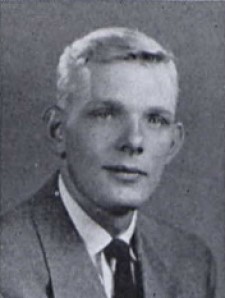“Iven Carl “Kinch” Kincheloe Jr. (July 2, 1928 – July 26, 1958) was an American pilot. He served in the U.S. Air Force during the Korean War, in which he was recognized as a flying ace.
He continued as a test pilot after the war, participating in the Bell X-2 program, in which he set an altitude record of 126,200 feet (38,470 m) in 1956. For this suborbital flight above most of the atmosphere, he became known as “The First Spaceman”. He was selected for the Air Force’s program to put a man in space, but was killed in a plane crash in 1958…
After the war, Kincheloe was a gunnery instructor at Nellis Air Force Base outside Las Vegas, Nevada, then resumed his activity as a test pilot (subsequent to his prior flight test activities associated with the F-86E), graduating in December 1954 from the Empire Test Pilots’ School at Farnborough, England. He participated in the testing of the Century Series of fighter aircraft (F-100 Super Sabre, F-101 Voodoo, F-102 Delta Dagger, F-104 Starfighter, F-105 Thunderchief, and F-106 Delta Dart).
In the mid-1950s, Kincheloe joined the Bell X-2 program and on September 7, 1956, flew at more than 2,000 mph (3,220 km/h) and to a height of 126,200 feet (38,470 m) (some sources list 126,500), the first flight ever above 100,000 feet (30,480 m), above 30 km (18.6 mi) and above 20 mi (32.2 km). For this he was nicknamed “America’s No. 1 Spaceman”. (However, this altitude is below the Kármán line, the threshold for “space” later established by the Fédération aéronautique internationale, as well as below the 50-mile-boundary used by the U.S. Air Force.) He was awarded the Mackay Trophy for 1956 for the flight…
In July 1958, Kincheloe was killed in the crash of an F-104A (Lockheed F-104A-10-LO s/n 56-772) at Edwards Air Force Base; he had ejected at low altitude, but given that the early F-104 used a downwards catapulted ejection seat the deployed parachute did not adequately slow his descent. He was buried with full military honors at Arlington National Cemetery. Only thirty years old, Kincheloe was survived by wife, Dorothy, their young son, Iven III, and a daughter who was born two months later, Jeannine.
On September 25, 1959, Kincheloe Air Force Base in Michigan’s Upper Peninsula was renamed in his honor; formerly Kinross Air Force Base, it closed in 1977.(1)
Source: Wikipedia
Iven Carl Kincheloe Jr, Capt USAF, “Headed West” on July 26, 1958.
 Pioneer Astronaut. Born in Detroit, Michigan, he was a natural pilot, soloing on his 16th birthday, and went on to be America’s first spaceman. Commissioned a 2nd Lieutenant in the US Air Force in 1949, during the Korean War he flew a F-86E Sabre Jet and was a double ace.
Pioneer Astronaut. Born in Detroit, Michigan, he was a natural pilot, soloing on his 16th birthday, and went on to be America’s first spaceman. Commissioned a 2nd Lieutenant in the US Air Force in 1949, during the Korean War he flew a F-86E Sabre Jet and was a double ace.
After the war, he was promoted Captain and became a test pilot at Edwards Air Force Base, California. In the early 1950s, at Edwards he test flew the new fighters McDonnell F-101, Convair F-102, Lockheed F-104 and Republic F-105. He became part of the new research Bell X-2 plane project in May 1956, with the goal to reach an altitude of 100,000 feet or higher.
On September 7, 1956, Kincheloe piloting the Bell X-2 reached the top of its curve at 126,500 feet, above the earth’s atmosphere, and was the first man in space. He was selected to be pilot of the more powerful rocket plane, the X-15, but lost his life when his F-104 crashed on takeoff at Edwards Air Base on July 26, 1958.
Bio by: John “J-Cat” Griffith















